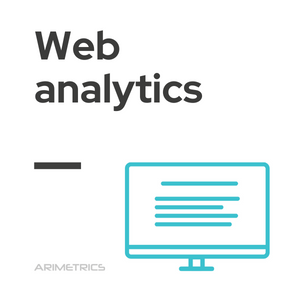
Definition:
Web analytics is the measurement, collection, analysis and reporting of web data in order to understand and optimize its use. It evaluates and improves the effectiveness of a website, as well as helps companies measure the results of traditional printing or advertising campaigns disseminated, with the aim that they can make decisions based on reliable data.
It is not only about collecting a series of metrics, but about knowing which ones to use and for what, and always with the aim of understanding the user’s behavior on the web in order to optimize the efforts of recruitment, interaction and conversion within it.
What is web analytics for?
Web analytics is a generic term, whose simplest meaning is the study of the impact of a website by its users. It also includes app analysis.
In a web analytics process, various web tools are used to measure details such as:
- How many people have visited your site.
- How many of those visitors were repeat visitors.
- Through what source and a half they came to the site.
- What are the landing pages that users reach.
- How long they stay on a given page.
- How much they remain throughout the site.
- What interactions they have carried out.
- To what extent they have met the objectives.
Web analytics tools
Web analytics tools can also be used to monitor whether or not the pages of a site are working properly. With this information, you can determine which areas of the site are the most popular areas and which part of the site does not get much traffic, and thus optimize it.
Web analytics provides these site administrators and their publishers with data that can be used to streamline a website and create a better user experience, improving their visits and results.
Among the most common Web Analytics tools we can mention:
- Google Analytics (reporting) and Google Tag Manager.
- Adobe: Adobe Analytics (report) and Dynamic Tag Manager.
- Matomo (formerly known as Piwik): Matomo Analytics (report) and Matomo Tag Manager.
Web analytics is not just a process of measuring web traffic, as it can be used as a tool for researching companies and the market, and to evaluate and improve the effectiveness of a website. It is an aid to estimate how much traffic changes to a website after the launch of a new advertising campaign, for example. It also helps to calibrate traffic and popular trends, which is very useful for market research.
Phases of web analytics
Web analytics is an optimization process that comprises the following phases:
- Definition of business objectives.
- Selection of KPIs to measure the fulfillment of the objectives.
- Technical implementation.
- Data collection and structuring.
- Analysis and reporting with proposals for improvements.
- Test of improvements.
- Implementation of improvements.
Questions web analytics answers
Web Analytics responds to the need to know the behavior of users in a website or app, and requires a complete analysis of everything that happens in it, and answer questions such as:
- Why does this website exist?
- What are its objectives?
- How can they be measured?
- What’s happening on the web?
- How can we contribute to meeting the objectives?
- What hypothesis do we want to test?
- Can we apply improvements after the results of the tests?
All these questions help to elaborate a systematic and scientific methodology to obtain through the data actionable conclusions to improve the expected performance of a website. Understanding this is fundamental for any marketing and business strategy, and is the reason why all companies with projection give more and more importance to their web analytics departments, a discipline that has become key to be able to compete in the online world.
